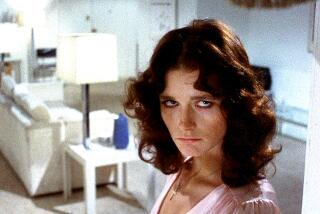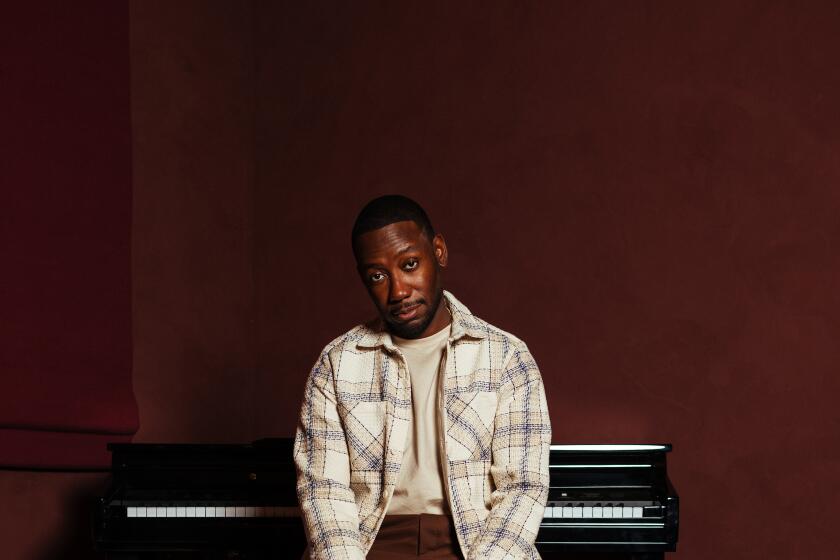His Life Is Their Canvas
With “Van Gogh’s Van Goghs” drawing capacity crowds at the Los Angeles County Museum of Art, it’s clear the artist has star power. There aren’t any other dead 19th century paupers with such a commanding presence in the 20th century media-entertainment complex.
And as it is with stars, the fans want a piece of the celebrity. In an age when tabloids and TV are saturated with salacious details about celebrities’ lives, the public’s renewed fascination with the life and legend of Van Gogh isn’t too surprising.
Film serves as a pop-cultural Esperanto, a universal language of typecasting that has provided America and the world with recognizable stock characters: the corrupt, portly politico; the femme fatale; the heroic, aw-shucks GI; the hooker with a heart of gold. Artists in particular have benefited and suffered from their depictions in the movies. Filmmakers have nurtured the popular image of the artist as a feral genius too consumed by the search for truth and beauty to follow the rules of polite society. Michelangelo, Toulouse-Lautrec, Leonardo and more recently Picasso have been dramatized in this fashion.
The Hollywood artist is a variation on a late-19th century theme, the larger-than-life passionate outsider too possessed of vision to bother with mortality or morality, much less mundane life. Whether it’s brand-name artists in a bio-pic or a paint-splattered hunk bedding the female lead in any number of thrillers, melodramas or love stories, Hollywood casts artists as lone wolves, bad boys and divine bums. And that’s the case with Van Gogh.
Films on Van Gogh have ranged from Art History 101 documentaries to lush Hollywood epics to the imagining of Japanese director Akira Kurosawa. Hollywood has repeatedly believed the artist to be good box office--or at least a good fit for the three-act movie formula, starting in 1956 with director Vincente Minnelli’s opulent melodrama “Lust for Life.” Robert Altman stripped Van Gogh’s life of MGM romanticism with “Vincent & Theo” (1990), portraying the artist, according to star Tim Roth, as a “cross between Jesus Christ and Sid Vicious.” Other major dramatized visions of Van Gogh include the French epic “Van Gogh,” directed by Maurice Pialat, and Kurosawa’s “Dreams,” a series of the Japanese director’s impressions, fantasies and nocturnal premonitions, featuring an enigmatic, poetic episode with Martin Scorsese as Van Gogh.
(TV producer Larry Thompson, whose biographical TV movie subjects include the Duke and Duchess of Windsor, Lucy and Desi and, most recently, Sonny and Cher, told Variety’s Army Archerd recently he’s talked to the Van Gogh estate about a new version of the artist’s life.)
But what exactly is Van Gogh’s appeal to filmmakers? “No one fared so poorly in their life and has been so highly regarded afterward,” says Ian Birnie, director of the film department at LACMA, who showed these four Van Gogh films just before the exhibition opened. “He attracts filmmakers because his is the drama of failure. I think that resonates for creative people.”
Kirk Douglas, who portrayed the artist in “Lust for Life,” agrees. “There’s a poignancy to Van Gogh that touches everybody. He only knew rejection, he didn’t know what a great artist he was, he didn’t succeed in his relationships with other people. Everyone can identify with failure.”
Among name-brand artists, Van Gogh makes for dramatic, compelling narrative in a way the life of contemporaries like Monet, Renoir or even Matisse simply wouldn’t. Each was a great artist, but having enjoyed success in their lifetimes, they lived as part of the bourgeoisie. In contrast, Van Gogh’s shocking use of color wasn’t the taste of the art-buying public in a late Victorian era fond of somber hues, dark wood and houses with little light. But an eventful, difficult life and dramatic vindication in the afterlife make Van Gogh a renewable resource for filmmakers.
“His dramatic persona can be seen in acts,” Birnie says. “You have the hero, the genius, the victim, the madman. With all these elements, shifting around the emphasis creates a whole new film.”
Where Minnelli emphasized the melodrama and madness, Kurosawa the poetry and Pialat the debauchery, Altman homed in on the day-to-day realism of being Van Gogh.
“We tried not to be so reverent,” said Altman. “When ‘Vincent & Theo’ was presented to me I said I wasn’t interested, but then I thought it could go against the grain of the Minnelli film. Most biographies are romantic renditions, and there’s nothing wrong with that. But I tried to take the awe and romanticism out and show in a truthful manner what possibly and more likely happened. He just painted and tried to hustle his brother out of money.”
Altman took his lead in a way from Van Gogh himself, who once wrote, “Instead of trying to reproduce exactly what I have before my eyes, I use color more arbitrarily, in order to express myself forcibly.” “Vincent & Theo” fudges facts and chronology to express Van Gogh the man more forcibly.
As Roth recalls, “Bob was wonderful about that. He loved to trash paintings, lie, play with the resume, it didn’t matter. It was in the spirit of Van Gogh who angered the people who knew better.”
Interestingly, despite glaring differences in style and story, the MGM CinemaScope melodrama, the critically acclaimed art film and the austere European bio-pic are surprisingly in sync about the character of Van Gogh. The more recent films may spend more screen time on the debauchery and whoremongering, but even the Eisenhower-era “Lust for Life” makes clear that the one domestic arrangement in Van Gogh’s life was with a “laundress” who does what she needs to “to get by.”
“It’s not like apples and oranges,” says Birnie. “The portrayals are remarkably consistent throughout all the movies. “
“Minnelli and I agreed completely on how Vincent should be played in ‘Lust for Life,’ ” recalls Douglas, who was nominated for an Oscar for his Van Gogh.
*
To prepare for the role, he read Vincent’s letters to his brother Theo and presented Minnelli with his take. Where Douglas played Van Gogh with increasingly desperate hysteria, Roth’s work in “Vincent & Theo” is crude, intense, the man disappearing into the husk of the artist. But the motivation behind the portrayal was essentially the same.
“He was a failure, and through his letters you know he thought he was a failure,” says Roth. “Although he was one of the greatest painters ever, you have to be recognized in your lifetime in your field to succeed and he wasn’t.”
Altman’s film begins effectively with footage of Van Gogh’s “Sunflowers” being auctioned off at Christie’s in London in 1987 for $39.9 million, before cutting to a filthy, ragged Van Gogh castigating his brother and benefactor.
The irony of Van Gogh’s failure in life and superstardom in death is not the only vein the actors and filmmakers wanted to capture. It was also the painter’s difficult, antisocial, demented behavior.
“He was undoubtedly mentally unbalanced,” Altman says. “I think he was driven mad by alcohol and turpentine. In every one of his famous letters to Theo he is asking for money. Theo kept all of Vincent’s letters, but Vincent didn’t save a single letter from Theo. That tells me that he didn’t care what his brother had to say as long as he got the money.”
“The letters that are missing say just as much if not more about the man than the letters we have,” Roth agrees. “He was an insightful, caring, passionate individual when he needed to be. Then he got his money and went off. No matter how fascinating he was, and people who obsess are fascinating, do you really want to sit down and have a drink with this man? Probably not.”
“I think he would have been difficult to have as a friend,” Douglas offers. “I believe it’s the audience, not the actor, who should get lost in the character. I just finished my 82nd motion picture, and ‘Lust for Life’ was the only one I couldn’t watch for more than a year. It was such a consuming, emotional experience for me, contrary to all my theories about acting.”
As the artist in “Van Gogh,” Jacques Dutronc won the French version of the Oscar as best actor, playing him as an ill-tempered, morose lech, begrudging the Impressionists their success and seducing the 15-year-old daughter of his patron, Dr. Gachet. He alienates everyone around him, including the brother on whose allowance he lives. While there’s really no additional biographical material in “Van Gogh,” there is greater emphasis on the unpleasant and violent behavior of his deterioration.
While directors and actors portraying Van Gogh have focused on the relatively contemporary themes of worldly failure, artistic genius and psychological crisis, that doesn’t mean the cinematic Van Goghs are definitive versions.
In reality, Van Gogh was a failed clergyman, and throughout his life, through his art and letters, he explored the conditions of the working class. The unfashionable and arguably uncinematic emphasis on the political, social and spiritual themes in Van Gogh’s life have yet to be filmed.
The movies that do exist are a testament to Van Gogh as a prototype of the modern artist whose 19th century concerns can be read as those of a thoroughly modern man.
“You can read anything you want into Van Gogh,” Roth says. “We have the paintings and the letters. The rest we can make up.”
More to Read
Only good movies
Get the Indie Focus newsletter, Mark Olsen's weekly guide to the world of cinema.
You may occasionally receive promotional content from the Los Angeles Times.










